
In the crowded world of movie adaptations of Japanese manga, Director Shinsuke Sato has carved a high place for himself, helming critically-lauded live-action versions of GANTZ, I AM A HERO, 2016ís DEATH NOTE, and INUYASHIKI. Sato-san set himself quite a challenge by taking on the immense world of Kubo Titeís fan-favourite, BLEACH, the story of a not-quite-average 15-year-old boy who sees dead people.
At Japan Cuts' US premiere of BLEACH, Director Sato spoke with LMD about supernatural samurais, CGI, and giving the fans what they want.
Dig it!
BLEACH
Director Shinsuke Sato
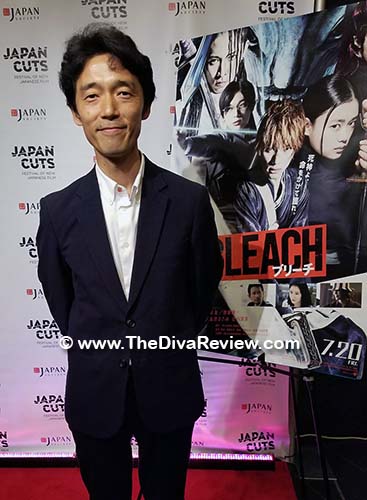
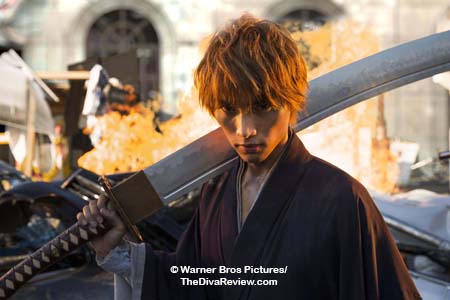 The
Lady Miz Diva: Director Sato, Iíve asked other filmmakers whoíve
adapted manga about adapting BLEACH, and every one of them said it would
be ďtoo hard.Ē What made you take up the challenge?
The
Lady Miz Diva: Director Sato, Iíve asked other filmmakers whoíve
adapted manga about adapting BLEACH, and every one of them said it would
be ďtoo hard.Ē What made you take up the challenge?
Shinsuke Sato: Regarding BLEACH, of course, I liked BLEACH from the very beginning. Itís always been something very interesting to me. Also, something regarding in a different matter, Iíve always wanted to make a film that had sword action, but that was set in today, or contemporary times. I always felt that sword action movies doesnít always have to be jidaigeki, but instead can be set in this contemporary time, now, and that perhaps Japanese films should have more of that kind of film. So, the film buff side of me wanted to do this kind of project. That said, if I were to make this kind of film through an original script; itís harder to manage to receive a budget, and actually make this project happen.
However, then, BLEACH came about to me. And I liked BLEACH to begin with, but it also allowed me to play out this dream as a filmmaker, as well. So, in a lot of ways, I wanted to intensely do this project; I had a want to do it.
Also, visually speaking, in my past works, for example, with DEATH NOTE in 2016, I incorporated CGI to do the Shinigami character. Also, in my past work, GANTZ, I also had an action and CGI combination happen within my films.
So, in a lot of ways, through my past work, Iíve been doing some trial and error. So, through that, BLEACH itself as a project, I worked in it for three years: It was finally in that moment that I started working that I felt like, ĎOkay, now I have the confidence to be able to do this film.í I felt that I could finally do it, and of course, I really had the want to do it.
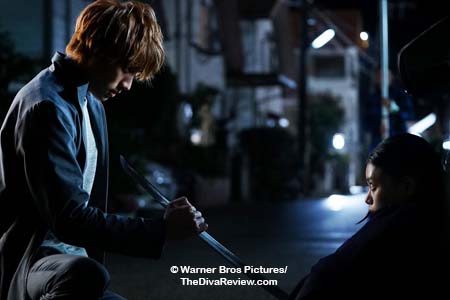 LMD:
How were you able to break down the enormous world of BLEACH into a
movie-sized fragment? You began your career as a screenwriter; I wonder
if that experience helped you to pare the large story down to its
essentials?
LMD:
How were you able to break down the enormous world of BLEACH into a
movie-sized fragment? You began your career as a screenwriter; I wonder
if that experience helped you to pare the large story down to its
essentials?
SS: When this project started, there was already a screenwriter who had spent quite a significant amount of time working on the script. This was a different scriptwriter. However, as you said, it is very, very difficult to put this world of BLEACH into two hours. And so, as you mentioned, I had been working as a screenwriter; I have experience in screenwriting, so, I, in fact, joined the scriptwriter in writing this script together. Finally, we were able to come to a script that we could agree on. We did spend a lot of time on the CGI with this film; we spent about a year, but the thing is, we spent almost the same amount of time working on the script in order to make this happen.
This film itself is about one hundred minutes; if you take away the credits, itís about ninety-five minutes long. So, really, you rush through the plot, and you rush through a lot of BLEACH within this short amount of time; but within this time, I wanted to make sure that BLEACHís essence and the story was there. And also, that it was something that could be presented to those who werenít very familiar with BLEACH, either. But then again, I also wanted to make sure that it doesnít become a summary of BLEACH; these were the considerations I was making. I also wanted to make sure that it was sort of kind of a boy-meets-girl story, as well, which you see within the film.
And so, all of these things are things that I considered, and therefore, I took a lot of time in building up the script.
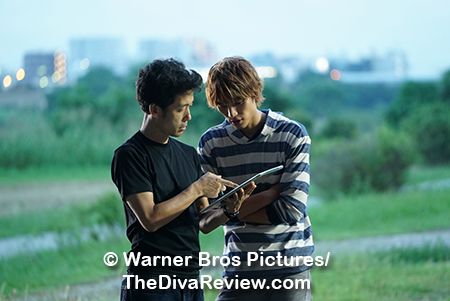 LMD:
Please talk about your lead actors. I felt Fukushi Sōta really captured
Ichigoís mannerisms, voice, and spirit. If I closed my eyes, I
thought it was BLEACH seiyuu, Morita Masakazu
speaking. Did you have Fukushi-san and the rest of the cast research
the characters in anime or manga to prepare?
LMD:
Please talk about your lead actors. I felt Fukushi Sōta really captured
Ichigoís mannerisms, voice, and spirit. If I closed my eyes, I
thought it was BLEACH seiyuu, Morita Masakazu
speaking. Did you have Fukushi-san and the rest of the cast research
the characters in anime or manga to prepare?
SS: So, as much as possible, especially speaking about my initial wants; in Japan, there is, of course, the manga, which is the original of BLEACH, there is the anime, as you spoke of, but in Japan, there is also the theatre production of BLEACH that exists. As a filmmaker, I really try to make sure that my film is not just a copy of any of these things. That is something that I try to keep in mind as a filmmaker, myself.
Regarding Fukushi-san, he had studied up quite a bit for the character of Ichigo. He had read the manga, and he spoke himself that he was indeed influenced by the originals, and the other adaptations, as well. That said, I wasnít alongside him for this process, but I do want to say that Fukushi-san really did study up.
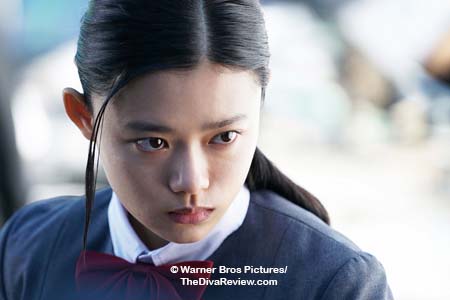 LMD:
I was a little curious about Sugisaki Hana as Rukia, because she didnít
look like the character to me, but her performance is perfect. How did
you know she was the one?
LMD:
I was a little curious about Sugisaki Hana as Rukia, because she didnít
look like the character to me, but her performance is perfect. How did
you know she was the one?
SS: Rukiaís character... Itís true, that Sugisaki-sanís appearance is quite different, but I felt that Sugisaki-sanís character, and her appearance, and perhaps the atmosphere that she gives off, felt quite right to me for Rukiaís part. So, this is also somewhat my estimation after thinking about her, but through that estimation, I offered this role to her. And again, as I mentioned, I think Sugisaki-san is quite different from Rukia in many ways, but I felt that Sugisaki-san is able to present Rukiaís hardness, as well as her softness, and worked quite well with the actors, such as Fukushi-san, in being able to portray this role. And so, I figured that Ichigo would try to help a character like Rukia, when itís presented through Sugisaki-san. This is something I imagined.
I actually had to try it to know it, but this is something I thought about, and therefore, I offered the role. I felt that Sugisaki-san was able to show a weakness that is behind her harder exterior, and personally, I really believe in the power of Sugisaki-san as an actress. I highly respect her, and therefore, I really wanted her to play Rukiaís role.
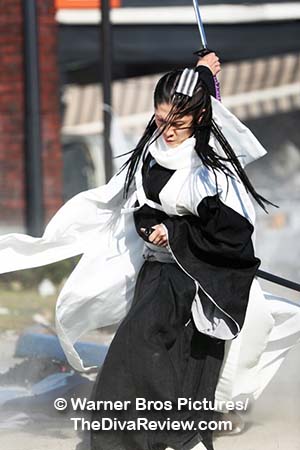 LMD:
You cast the rock star Miyavi as the regal Shinigami, Byakuya. That
surprised me. I saw him more as someone like Renji -- a wild character,
but what did you see in Miyavi that made you think he was right?
LMD:
You cast the rock star Miyavi as the regal Shinigami, Byakuya. That
surprised me. I saw him more as someone like Renji -- a wild character,
but what did you see in Miyavi that made you think he was right?
SS: Itís true that he couldíve played the role of Renji, in the way that you mentioned; that he is very rock star-like, but emotionally speaking, I actually wanted the actor who ended up playing Renji, Saotome {Taichi}-san to play this character, because he is able to present a depth and anger as an actor, and have that emotiveness, and he had that very harsh way of being able to present that. He, himself, is an actor who has been working in theatre, and I really like his expressiveness, and therefore, I gave him that role.
Going back to Byakuya, I really feel that Miyavi has a presence of some otherworldliness, and I felt that it would be perfect for somebody like Byakuya. Byakuya, himself, is at a very different level of swordsmanship: He has sort of like a godlike, samurai-like way of being able to wield the sword, and Miyavi, himself, who could wield guitar in a very godlike manner, it made me think that those two ideas synced together very well to me, and felt right. Therefore, through my imagination of what that would start to look like, I offered him that role.
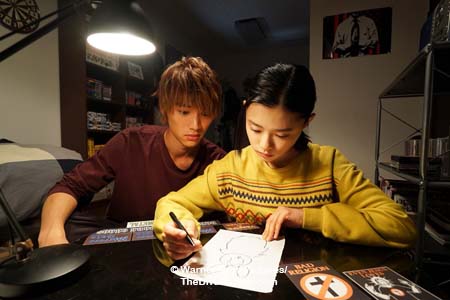 LMD:
Iím curious what you were allowed to change, and perhaps what you had to
keep in? There were some differences, or new looks at things in the
original; including the layout of the Seireitei, but as you know,
Ichigoís evolution is a huge part of the story of BLEACH.
LMD:
Iím curious what you were allowed to change, and perhaps what you had to
keep in? There were some differences, or new looks at things in the
original; including the layout of the Seireitei, but as you know,
Ichigoís evolution is a huge part of the story of BLEACH.
In the manga, our first glimpse of his evolution is evident during this filmís timeframe, but we donít actually see that onscreen. It made me wonder whether this film was planned to be a self-contained, one-shot movie, and so loose ends were avoided?
SS: One thing that I was told by the original mangaka, Kubo Tite-san, had asked me to keep, was the relationships between the characters. He wanted me to be very true to that, to the original. Which is a promise that I kept.
And one more, the other thing that I tried to keep, was that in Japanese cinema, we are unable to ensure that there will be part ten, or that there will be a franchise; itís just impossible to budget for something like that. Itís not like the TRANSFORMERS series, where you know that something else is coming up, because we are working with a limited budget in Japan. So, I really wanted to make sure that the audience is able to enjoy it with this one film.
So, in other words, what we did was pour all of our budget, and all of our efforts into this one film. And as I said, itís just impossible to develop a project in a way where we know that weíre going to have part two, three, and four. Both myself and the producer felt that we donít want to make a film where we pretend that there is going to be a part two.
Itís true that a lot of people have asked me whether there is going to be a part two to BLEACH, and to be honest, both myself and my producer really want to make part two, but it all really depends on how well the first film does in the box office. I definitely didnít want to make a BLEACH movie where, if there wasnít going to be a number two, I didnít want to make a BLEACH movie that became indigestible to people. I also wanted to make sure that people who donít know the manga can still enjoy it, and can still understand what the movie was doing. In that sense, there are differences from the original in order to be able to achieve that.
LMD: Leading into tonightís US premiere, I read that the film opened to rave reviews in Japan, so does it seem maybe closer to a part two?
SS: {Laughs} Well, so, Iíve been away from Japan for at least a week, now, so I need to go back and talk to my producer, and figure out whatís possible. I donít know anything, yet.
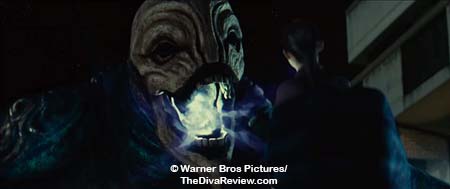 LMD:
From the GANTZ films, and INUYASHIKI, and now here in BLEACH, your
visual effects are so impressive. What was the most challenging
visual for BLEACH?
LMD:
From the GANTZ films, and INUYASHIKI, and now here in BLEACH, your
visual effects are so impressive. What was the most challenging
visual for BLEACH?
SS: In the original, the fight with the Grand Fisher, the fight with Renji, and the fight with Byakuya; those happened separately, but within this film, I actually cut these episodes together. The scene where Ichigo fights with the Grand Fisher in the original happens in the forest near a graveyard, and then the other two happen in the streets. Then thereís a part in the original, where he fights Fishbone, and that also happens in the streets.
So, I decided in the final setting of this film, in the climax, I wanted to create a set, which is Karakura Town station. Karakura is the town that you see throughout BLEACH, so I wanted to create a station front, and set the scene here. This is the setting that doesnít appear in the original, but I wanted to make this a sort of important factor within the film. This Karakura Town station in the film is built by actual studio sets, but also with CGI, so itís an imagined place thatís created by these two things, collaborating together.
So, in the final fight scene, you start off in the graveyard, but then it goes into this station setting. This setting, I wanted to make sure it dilapidates to something that doesnít look like todayís Tokyo by the end of the scene. The Soul Society doesnít show up in this movie, but I wanted to make it seem as if it suggests Soul Society in the way the town ends up.
And so, working with the set, and the CGI together -- a lot of the background work was done by CGI, and of course, the Grand Fisher monster is a CGI -- but then, within that scene, thereís also the human versus human fighting thatís happening. Then thereís the Grand Fisher, and action; so all the action has to be very high speed with the Grand Fisher.
That was a lot of challenges that I attempted, but I believe that I put all my experiences from my past work all together, and tried to challenge myself to go beyond all my past experiences, and really gave it my all, and tried very hard. In order to get to this place, it really did take a lot of preparation.
 LMD:
Where is Kon?
LMD:
Where is Kon?
SS: Ah, {Laughs} I actually did cut Kon this time. {Laughs} I am very sorry.
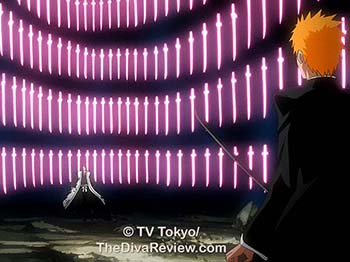
LMD: Fun question for you: As a BLEACH fan, yourself, if you could have your own Zanpakutō {Shinigami sword}, which would you choose?
SS: I think Senbonzakura is the coolest one. If I have a chance to do that {in another film}, I will.
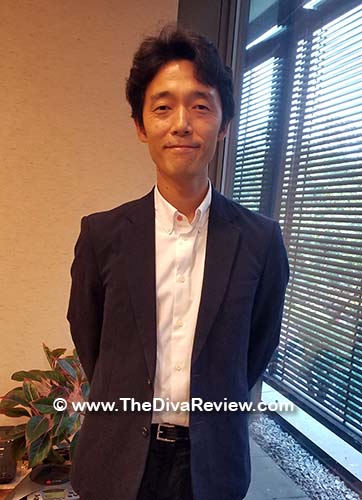 LMD:
Would you please give a message to the New York BLEACH fans, who cannot
wait to see your film?
LMD:
Would you please give a message to the New York BLEACH fans, who cannot
wait to see your film?
SS: Of course, I love BLEACH. Visually speaking, I want to make sure that people who are looking forward to the movie do enjoy it. And so, I want people to be able to watch this live-action BLEACH, this two hours BLEACH with completely new feelings and excitement.
I want to try to make sure that people who want to see this film get to see it. As of now, we only have these two screenings set up in the US, in New York, but for those who arenít able to see it, I am working very hard to make sure that anybody who wants to see it, is able to.
~ The Lady Miz Diva
July 28th, 2018
© 2006-2022 The Diva Review.com
|
|




























































